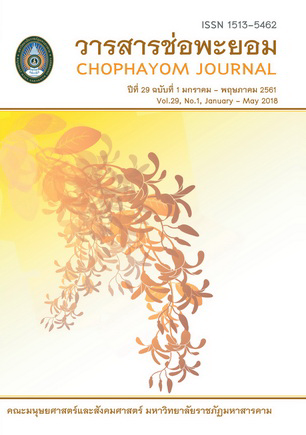กระบวนการจัดการธุรกิจเงินกู้นอกระบบในเขตเทศบาลเมืองมหาสารคาม จังหวัดมหาสารคาม Informal Loan Managerial Process as a Case Study of the Boundary of Maha Sarakham Municipality, Maha Sarakham Province.
Abstract
บทคัดย่อ
การวิจัยครั้งนี้มีวัตถุประสงค์เพื่อ (1) ศึกษาสถานการณ์ที่ทำให้เกิดธุรกิจปล่อยเงินกู้นอกระบบในเขตเทศบาลเมืองมหาสารคาม จังหวัดมหาสารคาม (2) ศึกษาภูมิหลังของเจ้าของธุรกิจปล่อยเงินกู้และผู้กู้ในธุรกิจเงินกู้นอกระบบ และ (3) ศึกษากระบวนการปล่อยเงินกู้นอกระบบ รวมไปถึง หลักเกณฑ์ในการปล่อยเงินกู้ วิธีการกู้ยืมเงิน (แบบมีหลักทรัพย์และไม่มีหลักทรัพย์ในการทำสัญญา) การชำระหนี้คืนเมื่อครบกำหนด การติดตามเงินกู้ค้างชำระ ยุทธศาสตร์ในการไกล่เกลี่ยหรือการเจรจาเพื่อประน้อมหนี้ และการเข้าสู่กระบวนการยุติธรรมในระบบปกติโดยใช้การศึกษาแบบผสมทั้งเชิงปริมาณและเชิงคุณภาพ ด้วยการเก็บข้อมูลจากกลุ่มตัวอย่าง 170 คน และผู้ให้ข้อมูลสำคัญ 20 คน โดยใช้เครื่องมือคือแบบสอบถามและแบบสัมภาษณ์ผลการศึกษาพบว่า ผู้กู้เงินนอกระบบส่วนใหญ่ใช้วิธีการติดต่อผู้ให้กู้โดยไปพบโดยตรง คิดเป็นร้อยละ 57.06 ทั้งนี้ ในแง่ของการทำสัญญาเงินกู้ ร้อยละ 78.82 สะท้อนว่าแหล่งเงินกู้นอกระบบต้องทำสัญญา โดยร้อยละ 72.35 ไม่มีการคํ้าประกัน ส่วนในกรณีที่ผิดนัดชำระหนี้ ส่วนใหญ่ คิดเป็นร้อยละ 53.53 ขอผ่อนผันได้แต่ต้องเสียค่าดอกเบี้ย รองลงมา คือ ถูกยึดสิ่งที่นำมาคํ้าประกัน คิดเป็นร้อยละ 25.29 และน้อยที่สุด คือถูกข่มขู่ทำร้ายร่างกายหลังจากที่ผิดนัดจ่ายมาหลายครั้ง คิดเป็นร้อยละ 1.76 ในส่วนของการฟ้องดำเนินคดีเข้าสู่กระบวนการยุติธรรมส่วนใหญ่ไม่เคยถูกฟ้องดำเนินคดี คิดเป็นร้อยละ 87.06 สำหรับช่วงระยะเวลาที่มีผู้กู้เงินกู้นอกระบบมากที่สุดคือในช่วงเดือนเมษายน-มิถุนายน และในรอบปีที่ผ่านมาผู้กู้ส่วนใหญ่กู้เงินกู้นอกระบบ 3 ครั้ง โดยส่วนใหญ่ คิดเป็นร้อยละ 78.82 กู้เงินนอกระบบแบบรายเดือน ในด้านวงเงินกู้สูงสุด ส่วนใหญ่ผู้กู้เงินกู้นอกระบบใช้วงเงินกู้สูงสุดจำนวน 10,001 -30,000 บาท คิดเป็นร้อยละ 60.00 รองลงมา คือ ตํ่ากว่า 10,000 บาท ในด้านของอัตราดอกเบี้ย ร้อยละ 60 จ่ายอัตราดอกเบี้ยเงินกู้นอกระบบร้อยละ 6- 10 บาท รองลงมา คือ ร้อยละ 2-4 บาท คิดเป็นร้อยละ 33.53 และน้อยที่สุด คือ ร้อยละ 16-20 บาท คิดเป็นร้อยละ 0.59 ทั้งนี้ ผู้กู้เงินกู้นอกระบบส่วนใหญ่ไม่เคยถูกผู้ให้กู้โกง คิดเป็นร้อยละ 89.41 โดยเมื่อกู้แล้วส่วนใหญ่ผู้กู้เงินกู้นอกระบบนำเงินไปซื้อสิ่งอำนวยความสะดวก คิดเป็นร้อยละ 59.41 รองลงมาคือ ชำระหนี้ที่อื่น คิดเป็นร้อยละ 37.06 สำหรับการคิดที่จะใช้บริการเงินกู้นอกระบบอีกครั้ง
ส่วนใหญ่คิดว่าจะใช้บริการอีก คิดเป็นร้อยละ 92.35 โดยร้อยละ 95.88 ไม่เคยคิดที่จะโกงเงินผู้ให้กู้ ในขณะที่ร้อยละ 4.12 คิดที่จะโกงเพราะเห็นว่าค่าดอกเบี้ยสูงเกินไปในส่วนของผู้ให้กู้เงินกู้นอกระบบ ส่วนใหญ่ไม่สนิทกับนักการเมืองท้องถิ่น ในขณะที่ ส่วนใหญ่สนิทกับตำรวจ ผู้ให้กู้สะท้อนว่า สภาพธุรกิจเงินกู้นอกระบบโดยทั่วไปกิจการเจรญิ รุ่งเรืองดีมากเนื่องมาจากปัญหา เศรษฐกิจ
ที่ตกตํ่า คนจึงขาดสภาพคล่องทางการเงินที่จะใช้ในการจับจ่ายใช้สอยในชีวิตประจำวัน พบว่า ผู้ให้กู้ต้องระแวดระวังมากขึ้นจากที่รัฐบาลมีแนวทางจัดการกับธุรกิจนอกระบบมากขึ้น สำหรับระยะเวลาที่ทำธุรกิจเงินกู้นอกระบบพบว่าผู้ปล่อยเงินกู้ได้ดำเนินธุรกิจมานานพอสมควร โดยส่วนใหญ่เป็นผู้ที่ทำการปล่อยกู้มาแต่ดั้งเดิม ส่วนสาเหตุและแรงจูงใจที่ทำธุรกิจนี้เนื่องมาจากผลประโยชน์ในเรื่องของค่าตอบแทนที่สูงที่ได้รับจากอัตราดอกเบี้ยที่ได้จากเงินต้นทุนของตนเอง อีกทั้งอาชีพนี้ไม่มีความจำเป็นที่ผู้ประกอบการจะต้องมีความรู้ความสามารถ ความเชี่ยวชาญในการทำงานมากนักและยังเป็นงานที่สบาย มีเวลาเป็นส่วนตัวเยอะและสามารถทำควบคู่กับงานประจำที่ทำอยู่ได้มากไปกว่านั้น ยังทำให้ตนรู้สึกถึงการมีอำนาจเมื่อถามถึงรูปแบบของการให้กู้ ส่วนใหญ่จะทำการกู้เงินออกมาในรูปแบบของการจดจำนองและการขายฝาก ในการคืนเงินจะคิดออกมาในรูปแบบของรายเดือน ซึ่งในการกู้แบบรายเดือนนั้นผู้ที่ประสงค์จะกู้ต้องมีการทำสัญญาที่เป็นลายลักษณ์อักษรและมีหลักทรัพย์ในการคํ้าประกัน เช่น โฉนดที่ดิน น.ส.3 รถยนต์ส่วนบุคคล รถจักรยานยนต์ โทรศัพท์มือถือและอื่นๆ ที่เป็นทรัพย์สินของมีค่าที่สามารถแปรรูปเป็นเงินได้มาวางไว้เพื่อเป็นหลักทรัพย์ในการคํ้าประกันเงินกู้ ทั้งนี้ นอกจากการนำเงินทุนส่วนตัวมาให้กู้ บางส่วนสะท้อนว่าไปกู้มาจากสถาบันการเงินอื่นๆ หรือนายทุนคนอื่นเพื่อนำมาปล่อยกู้ในการแสวงหาผลกำไรจากการกำหนดอัตราดอกเบี้ยที่แตกต่างกันไปในแต่ละบุคคลที่นำมาปล่อยกู้ อีกประเด็นคือผู้ให้กู้ส่วนใหญ่ไม่ทำการปล่อยเงินกู้นอกเขตพื้นที่ตนเองอาศัยอยู่ เนื่องด้วยมีค่าใช้จ่ายในการเดินทาง เวลา การติดตามทวงหนี้ และมองเป็นเรื่องที่ยุ่งยาก อีกทั้งได้รับการสะท้อนว่าผู้ให้กู้ส่วนใหญ่ไม่เคยโกงลูกค้าเลย เพราะการรักษาชื่อเสียงในวงการเป็นเรื่องสำคัญต่อความอยู่รอดของธุรกิจเงินกู้ ในขณะเดียวกัน จากผลการสัมภาษณ์พบว่าวิธีการหลักของการเจรจาไกล่เกลี่ยในการทวงหนี้คือการทวงถามและหาจุดเป็นไปได้บนฐานของการให้เกียรติลูกหนี้ด้วย บางคนเน้นยํ้าให้เห็นความสำคัญของความสุภาพ และการให้ทางเลือกลูกค้ารวมถึงฟังเงื่อนไขที่เขามีและแนวทางประนอมหนี้ที่เป็นไปได้สำหรับเขา ในขณะที่ บางคนเน้นขู่นำทรัพย์สินที่คํ้าไว้ไปขายหรือการเปิดโปงต่อสาธารณะให้เสียชื่อเสียง คำสำคัญ : ธุรกิจเงินกู้นอกระบบ, การจัดการมหาสารคาม
ABSTRACT
The purposes of this research are (1) to study the situation that facilitates loan shark businesses in MahaSarakham municipality, MahaSarakham province, (2) to study the background of loan shark business owners and borrowers in MahaSarakham municipality, MahaSarakham province, and (3) to study the process of loan shark including lending criteria, borrowing approach (with and without collaterals), loan repayment, debt follow up process, debt composition strategy, and process of judgment in general. Both quantitative and qualitative methods are used in this study. The data used in this study are from 170 survey questionnaires and 20 interviewees. The findings reveal that 57.06% of borrowers contact lenders by face to face. In addition, 78.82% of borrowers have signed paper contracts with lenders and 72.35% of the
contracts are without collaterals. In the case of debt default, 53.53% of borrowers can reach a compromise with lenders, but they still have to pay interest rate. There is 25.29% of borrowers whose collaterals are seized, and only 1.76% of them are intimidated by lenders after failure to repay debt for several times. However, 87.06% of the borrowers are never impleaded. Most of the borrowers prefer to borrow money in the period between April and June. Based on last year information, most of them borrow money three times and about 78.82% borrow money on a monthly basis, with the maximum amount that can be used is 10,001 - 30,000 Baht (60%), and the rest is the amount less than 10,000 Baht. For the interest payment, about 60% of borrowers pay at rate of 6% - 10% per month, 33.53% pay at rate of 2% - 4% per month, and only 0.59% pay at rate of 16% - 20% per month. There is pretty much of 89.41% of borrowers who are never defrauded by lenders. Once the borrowers get the money, 59.41% of them use it for consuming convenient goods, and 37.06% use the money for repaying another debt. About 95.88% of borrowers who have experience using the loan shark service have a tendency to use the service again. Moreover, 95.88% of borrowers never think to defraud lenders, and only 4.12% of them may defraud lenders because of high interest payment. For the lenders side, many of them have no connection with local politicians, but they have well connection with policemen. They think that the loan shark is a flourishing business in general, because most people do not have enough money to spend in daily life during economic downturn. Recently, the lenders have to be more cautious in doing the business since the government has stepped in to crack down on business. Most of the business owners have started running their business for a period of time. The motivations of doing the business are that they could have high return from interest payment. The owners do not need specific skill or
knowledge to run the business, and they can do it along with their permanent job, since the loan shark business require less time. Moreover, they also feel that they have the power over borrowers. When asking about lending approach, most of the lenders will lend out money in the form of mortgage and sale with right of redemption, and the payment method will be calculated on a monthly basis. In addition, the borrowers who want to borrow money on a monthly basis have to sign a paper contract and pledge collaterals for instance, title deeds, certificate utilizations (NS. 3K.), personal cars, motorcycles, mobile phones, and other liquid assets with the lenders. In addition to use their own capital for lending, some lenders have borrowed money from financial institutions or another capitalists for their business, in order to make a profit from the interest rate differentials. It is worth noting that most of the lenders will not make a loan beyond their living
area due to travelling cost, time waste, debt follow up, and inconvenience. Furthermore, many lenders would never defraud their clients because the trust is very important for their business to survive in the market. From the results of the case study interview, the lenders indicate the ways that they negotiate to reach a compromise with their debtors. They emphasize that respect and gentleness are very important when asking for debt repayment. Moreover, the lenders should provide options to borrowers or listen to their opinions in order to find possible solutions for them. However, some lenders would threaten borrowers that they will sell their collaterals or disclose their information to the public. Keywords : informal loan managerial process, the boundary of Maha Sarakham






